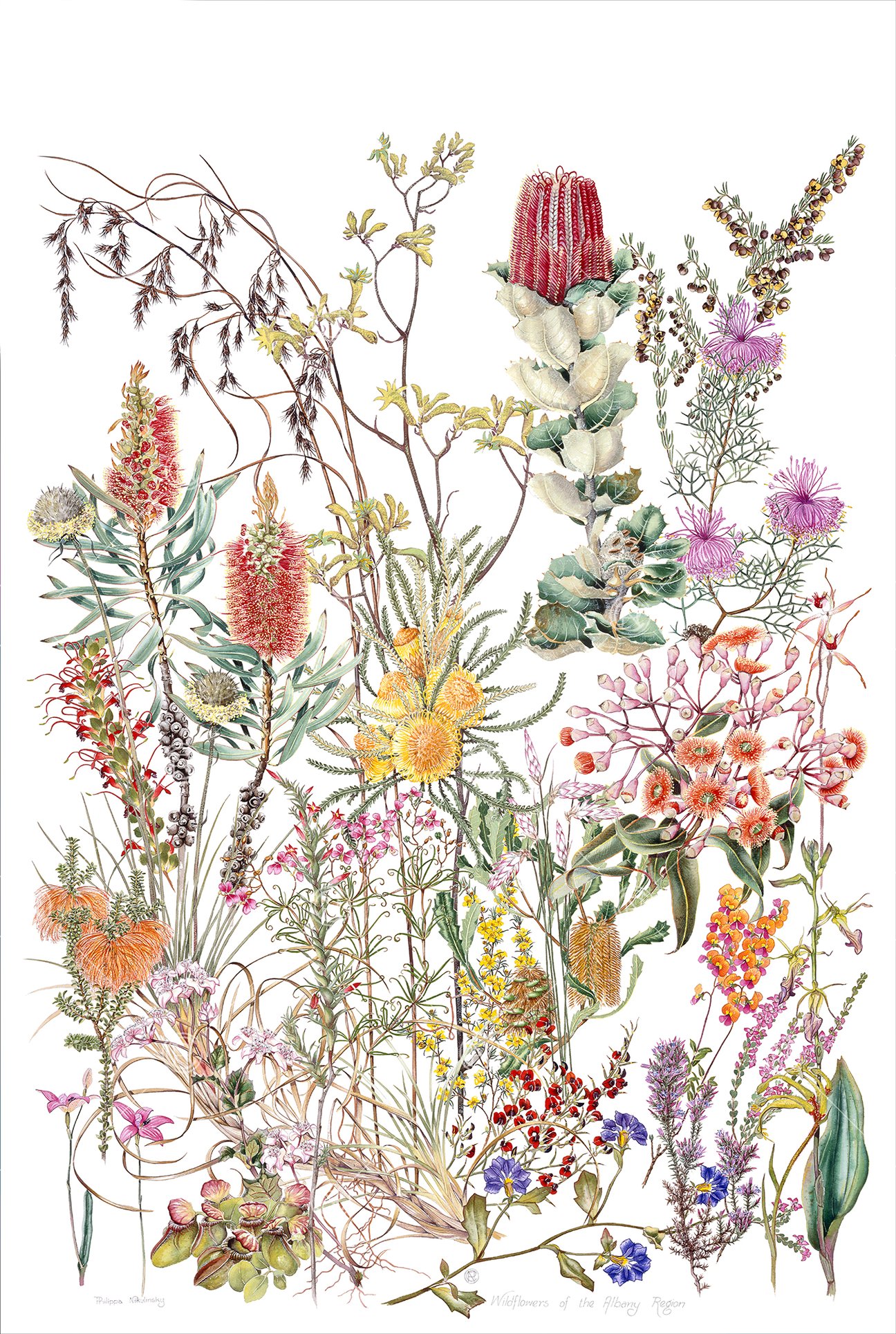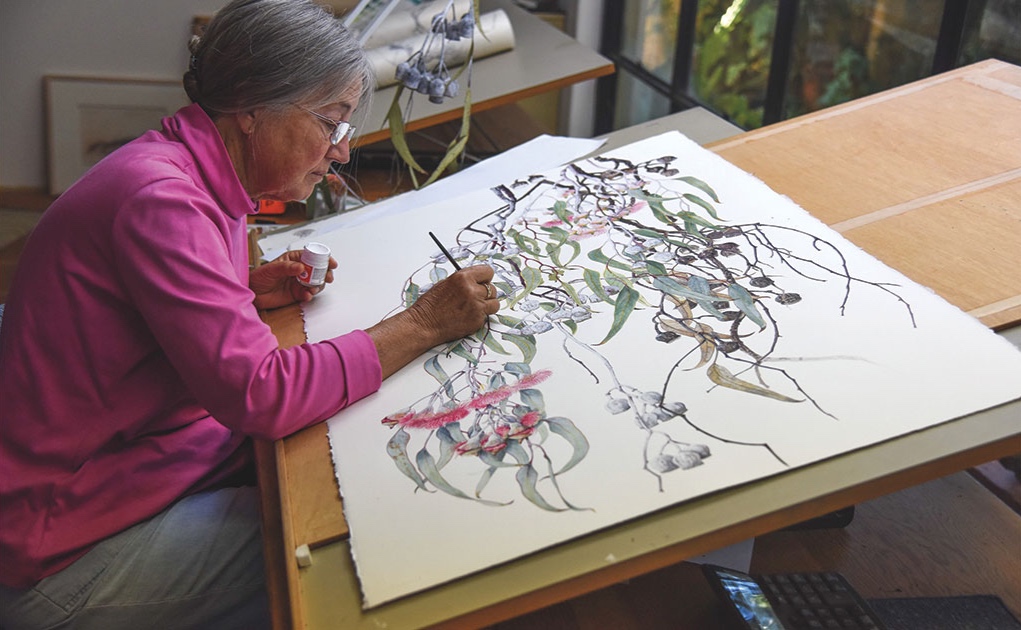Philippa Nikulinsky was an artist’s name I learned about when I visited Perth, Western Australia, last year. I had been shown some prints she had donated to the Nedlands Council buildings. They were exquisite, immensely detailed and knowledgeable depictions of Western Australian flowers. I was fascinated.
Lady Luck allowed me, this year, to catch a wonderful exhibition, almost a retrospective, of her work at the Lawrence Wilson Art Gallery, University of Western Australia. The show, Nikulinsky Naturally, runs from May 25 - August 17 2019, in a large and simple gallery space at the beautiful university campus.
It is an exhibition which needs careful enjoyment and study. It combines the work and experience of a long lifetime of going out in the bush all over the different environments of Western Australia, studying minutely the most varied of flora and fauna and the landscapes in which they live, and then bringing back those studies and written notes to the studio. The results are diverse and stunning.
For me, a visitor to Western Australia, they are a reminder of the vastness of this land and the diversity of terrain and climate, quite apart from the uniqueness of everything living and growing here. No wonder that historically, Western Australia has been a lodestone to botanists and plant collectors since the earliest European visitors to this land. Nikulinsky is heir to a long and illustrious heritage of botanical collectors, literally or in art who have brought fame to Australia, from Georgiana Molloy to Ellis Rowan or Margaret Stones.
The exhibition of Nikulinsky’s work starts with an amazing 1992 series of 23 watercolour, gouache and pencil representations of the wonderful Banksia menziesii, in all its stages from bud formation to flowering, fruiting, seed dispersal and final germination of a new plant. The work is scientific in its approach, a faithful recording in art form of the flower’s evolution, with emphasis on it rather than on the surrounding leaves which are just silhouettes for the most part.
As the Banksia menziesii spike begins to form, 1992, watercolour, pencil and gouache on hot-pressed Arches paper, Philippa Nikulinsky artist
Banksia menziesii follicles split open and the seeds have flown, 1992, watercolour, pencil and gouache on hot-pressed Arches paper, Philippa Nikulinsky artist
In an adjacent room, another extraordinary body of work dates from 1990 – 14 large original posters of watercolour botanical compositions of the wildflowers of different regions of Western Australia. Intricate weavings together of flowers and leaves, celebrations of the astonishing diversity of flora, utter botanical fidelity and a complexity of presentation to celebrate and instruct the viewer on the floral wealth of this State – a high achievement of botanical art allied to science.
Wildflowers of the Albany Region, watercolour, pencil, gouache on hot-pressed Arches paper, 1990, Philippa Nikulinsky artist
From there onwards, however, the alliance between science and art is more easy-going, more harmonious to my eye, with the balance towards art. Big watercolour sheets, 100 x 68 cm, allow for freedom and impact, with an increasingly oriental feel to the composition and less observance of Western traditional botanical art strictures of the centred image with white space around.
Eucalyptus sweedmaniana, watercolour and pencil on hot-pressed Arches paper, 2011, Philippa Nikulinsky artist
Eucalyptus macrocarpa, watercolour, pencil, gouache on hot-pressed Arches paper, 2015, Philippa Nikulinsky artist
The botanical fidelity is always there – the trained eye has recorded all the nuances in form, habit of growth and colouration – but the way Nikulinsky composes her version of reality is quintessentially artistic, wondrous in its delicacy and elegance. Her ability to organise the space and geometry of complex plants is breathtaking, both in her draughtsmanship and then use of colour to imply layers and space.
Philippa Nikulinsky finishing the painting of Eucalyptus caesia in studio, 2016, courtesy the artist
Banksia elderiana, watercolour pencil, gouache on hot-pressed Arches paper, 2018, Philippa Nikulinsky artist
Eucalyptus woodwardii(detail), 2016 – 2017, watercolour, pencil and gouache on hot-pressed Arches paper, Philippa Nikulinsky artist
Nikulinsky – to my eye – really comes into her own with her wonderful use of long horizontal or vertical scrolls of Kozo paper. These allow a melding between her classical botanical approach and the freedom and implied space that oriental art employs. There is, of course, always an impact implicit in an image four, five or more meters long, but also a challenge which Nikulinsky meets beautifully, with her friezes of complex bush scenery in all stages of evolution. One that documents the aeon-old cycle of fire, perhaps made more pertinent in today’s discussions of climate change and current heat-waves, is the seven-meter long panel called Xanthorroea thorntonni, Before and After the Fire, 2017-2018.
Xanthorroea thorntonni, Before and After the Fire, 2017-2018., part one, left to right, of the work, pencil and watercolour on Kozo paper, 2017-18, Philippa Nikulinsky artist
Xanthorroea thorntonni, Before and After the Fire, 2017-2018., part two, left to right, of the work, pencil and watercolour on Kozo paper, 2017-18, Philippa Nikulinsky artist
Xanthorroea thorntonni, Before and After the Fire, 2017-2018., part three, left to right, of the work, pencil and watercolour on Kozo paper, 2017-18, Philippa Nikulinsky artist
The issues of today’s world – climate change, Western approaches to recording nature visually, let alone the scientific nomenclature or indigenous name of each species, or even man’s historical relationships and use of land in this continent – fall by the way as you view Nikulinsky’s work. The sheer achievement of so many countless hours spent amid these diverse habitats to study and observe, understand, record and then paint or draw them is breathtaking. Political considerations seem far away – even science pales into insignificance. Just the tenacious passion and deep understanding conveyed by each work of art demand respect and admiration.
Enchanted Forest, 1997, 4.5 x 1m, pigment ink and gouache on Kozo paper, Philippa Nikulinsky artist.
Enchanted Forest Revisited, 2017, 5.5 x 1m, pigment ink on Kozo paper, Philippa Nikulinsky, artist
Wind-blown Cliff Top Shoal Cape, 2015 – 2016, 275 x 66cm, watercolour, gouache and pigment ink on Kozo paper, Philippa Nikulinsky artist
By the end of this exhibition, not only has the viewer been transported to lands where survival, individuality of species and beauty are paramount, but the art has instructed, fascinated and delighted en route. No small achievement.













